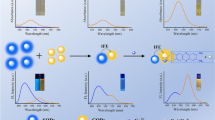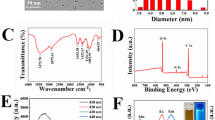Abstract
Herein, a dual-signal sensing strategy based on ratiometric fluorescence and colorimetry for Cu2+ and glyphosate determination was constructed. Fluorescence silicon nanoparticles (SiNPs) were prepared by hydrothermal reaction, which has maximum fluorescence intensity under the excitation of 355 nm. o-Phenylenediamine (OPD) was oxidized through Cu2+ to generate 2,3-diaminophenazine (oxOPD). The obtained oxOPD showed a strong absorption peak at 417 nm and quenched the fluorescence of SiNPs at 446 nm due to fluorescence resonance energy transfer (FRET). Meanwhile, oxOPD produced a new fluorescence emission at 556 nm forming a ratiometric state. With increasing Cu2+, the original solution changed from colorless to yellow. When glyphosate was present, the interaction between Cu2+ and the functional groups of glyphosate could reduce the oxidation of oxOPD, resulting in the enhancement of fluorescence at 446 nm and the decrease of fluorescence at 556 nm. Furthermore, the addition of glyphosate changed yellow solution to colorless. Under the optimal conditions of OPD (1 mM), 20 mM Tris–HCl buffer (pH 7.5), and incubation time (4 h), the ratiometric fluorescence sensor had good selectivity and showed a wide linear range of 0.025–20 μM with the LOD of 0.008 μM for Cu2+ and 0.15–1.5 μg/mL with the LOD of 0.003 μg/mL for glyphosate, respectively. Besides, it is worth mentioning that this developed sensing system showed good performance in real samples, providing a simple and reliable dual-signal detection strategy.
Graphical abstract









Similar content being viewed by others
References
Zhang XD, Chen XK, Yang JJ, Jia HR, Li YH, Chen Z, Wu FG. Quaternized silicon nanoparticles with polarity-sensitive fluorescence for selectively imaging and killing Gram-positive bacteria. Adv Func Mater. 2016;26(33):5958–70. https://doi.org/10.1002/adfm.201602185.
Han YX, Chen YL, Feng J, Liu JJ, Ma SD, Chen XG. One-pot synthesis of fluorescent silicon nanoparticles for sensitive and selective determination of 2,4,6-trinitrophenol in aqueous solution. Anal Chem. 2017;89(5):3001–8. https://doi.org/10.1021/acs.analchem.6b04509.
Zhu LJ, Peng X, Li HT, Zhang YY, Yao SZ. On-off-on fluorescent silicon nanoparticles for recognition of chromium(VI) and hydrogen sulfide based on the inner filter effect. Sens Actuators B Chem. 2017;238:196–203. https://doi.org/10.1016/j.snb.2016.07.029.
Li Q, Peng KT, Lu YZ, Li AX, Che FF, Liu YY, Xi XJ, Chu Q, Lan T, Wei Y. Synthesis of fluorescent ionic liquid-functionalized silicon nanoparticles with tunable amphiphilicity and selective determination of Hg2+. J Mat Chem B. 2018;6(48):8214–20. https://doi.org/10.1039/c8tb02109k.
Wan YQ, Tian ML, Xie WY, Li CM, Liu YS. One-step synthesis of amine-functionalized fluorescent silicon nanoparticles for copper(II) ion detection. Anal Bioanal Chem. 2019;411(24):6419–26. https://doi.org/10.1007/s00216-019-02020-9.
Du LQ, Li ZP, Yao JL, Wen GM, Dong C, Li H. Enzyme free glucose sensing by amino-functionalized silicon quantum dot. Spectrochim Acta Part A Mol Biomol Spectrosc. 2019;216:303–9. https://doi.org/10.1016/j.saa.2019.03.071.
Taheri M, Mansour N. Highly sensitive fluorescence assay for glucose using amine-terminated silicon quantum dots as a non-enzymatic bioprobe. J Electron Mater. 2019;48(9):5875–82. https://doi.org/10.1007/s11664-019-07368-3.
Ban R, Zheng FF, Zhang JR. A highly sensitive fluorescence assay for 2,4,6-trinitrotoluene using amine-capped silicon quantum dots as a probe. Anal Methods. 2015;7(5):1732–7. https://doi.org/10.1039/c4ay02729a.
Zhou Z, Gu JP, Chen YZ, Zhang XX, Wu HX, Qiao XG. Europium functionalized silicon quantum dots nanomaterials for ratiometric fluorescence detection of Bacillus anthrax biomarker. Spectrochim Acta Part A Mol Biomol Spectrosc. 2019;212:88–93. https://doi.org/10.1016/j.saa.2018.12.036.
Chu BB, Wang HY, Song B, Peng F, Su YY, He Y. Fluorescent and photostable silicon nanoparticles sensors for real-time and long-term intracellular pH measurement in live cells. Anal Chem. 2016;88(18):9235–42. https://doi.org/10.1021/acs.analchem.6b02488.
Li Q, Peng KT, Yu YC, Ruan XY, Wei Y. One-pot synthesis of highly fluorescent silicon nanoparticles for sensitive and selective detection of hemoglobin. Electrophoresis. 2019;40(16–17):2129–34. https://doi.org/10.1002/elps.201900023.
Zeng L, Miller EW, Pralle A, Isacoff EY, Chang CJ. A selective turn-on fluorescent sensor for imaging copper in living cells. J Am Chem Soc. 2006;128(1):10–1. https://doi.org/10.1021/ja055064u.
Wang J, Pan YN, Jiang LX, Liu M, Liu FY, Jia M, Li J, Lai YQ. Photoelectrochemical determination of Cu2+ using a WO3/CdS heterojunction photoanode. ACS Appl Mater Interfaces. 2019;11(41):37541–9. https://doi.org/10.1021/acsami.9b10256.
Balasubramanian K. Quantum chemical insights into Alzheimer’s disease: curcumin’s chelation with Cu(II), Zn(II), and Pd(II) as a mechanism for its prevention. Int J Quantum Chem. 2016;116(14):1107–19. https://doi.org/10.1002/qua.25145.
Yu SJ, Li W, Fujii Y, Omura T, Minami H. Fluorescent spherical sponge cellulose sensors for highly selective and semiquantitative visual analysis: detection of Hg2+ and Cu2+ ions. ACS Sustain Chem Eng. 2019;7(23):19157–66. https://doi.org/10.1021/acssuschemeng.9b05142.
Liu Y, Su QQ, Chen M, Dong Y, Shi YB, Feng W, Wu ZY, Li FY. Near-infrared upconversion chemodosimeter for in vivo detection of Cu2+ in Wilson disease. Adv Mater. 2016;28(31):6625-+. https://doi.org/10.1002/adma.201601140.
Davies KM, Mercer JFB, Chen N, Double KL. Copper dyshomoeostasis in Parkinson’s disease: implications for pathogenesis and indications for novel therapeutics. Clin Sci. 2016;130(8):565–74. https://doi.org/10.1042/cs20150153.
Perez AL, Tibaldo G, Sanchez GH, Siano GG, Marsili NR, Schenone AV. A novel fluorimetric method for glyphosate and AMPA determination with NBD-Cl and MCR-ALS. Spectrochim Acta Part A Mol Biomol Spectrosc. 2019;214:119–28. https://doi.org/10.1016/j.saa.2019.01.078.
Tarazona JV, Court-Marques D, Tiramani M, Reich H, Pfeil R, Istace F, Crivellente F. Glyphosate toxicity and carcinogenicity: a review of the scientific basis of the European Union assessment and its differences with IARC. Arch Toxicol. 2017;91(8):2723–43. https://doi.org/10.1007/s00204-017-1962-5.
Fortes C, Mastroeni S, Segatto M, Hohmann C, Miligi L, Bakos L, Bonamigo R. Occupational exposure to pesticides with occupational sun exposure increases the risk for cutaneous melanoma. J Occup Environ Med. 2016;58(4):370–5. https://doi.org/10.1097/jom.0000000000000665.
Myers JP, Antoniou MN, Blumberg B, Carroll L, Colborn T, Everett LG, Hansen M, Landrigan PJ, Lanphear BP, Mesnage R, Vandenberg LN, vom Saal FS, Welshons WV, Benbrook CM. Concerns over use of glyphosate-based herbicides and risks associated with exposures: a consensus statement. Environ Health. 2016;15:19. https://doi.org/10.1186/s12940-016-0117-0.
Meftaul IM, Venkateswarlu K, Dharmarajan R, Annamalai P, Asaduzzaman M, Parven A, Megharaj M. Controversies over human health and ecological impacts of glyphosate: is it to be banned in modern agriculture? Environ Pollut. 2020;263:114372. https://doi.org/10.1016/j.envpol.2020.114372.
Wang YY, Yang Y, Liu W, Ding F, Zhao QB, Zou P, Wang XX, Rao HB. Colorimetric and fluorometric determination of uric acid based on the use of nitrogen-doped carbon quantum dots and silver triangular nanoprisms. Microchim Acta. 2018;185(6):9. https://doi.org/10.1007/s00604-018-2814-6.
Wu C, Zhu L, Lu Q, Li H, Zhang Y, Yao S (2019) A dual-signal colorimetric and ratiometric fluorescent nanoprobe for enzymatic determination of uric acid by using silicon nanoparticles. Microchim Acta 186(12). https://doi.org/10.1007/s00604-019-3862-2
Wang J, Li DQ, Qiu Y, Liu XY, Huang L, Wen HM, Hu J. An europium functionalized carbon dot-based fluorescence test paper for visual and quantitative point-of-care testing of anthrax biomarker. Talanta. 2020;220:121377. https://doi.org/10.1016/j.talanta.2020.121377.
Wang J, Li DQ, Ye YX, Qiu Y, Liu JW, Huang L, Liang B, Chen BL (2021) A fluorescent metal-organic framework for food real-time visual monitoring. Adv Mater 33(15). https://doi.org/10.1002/adma.202008020
Ding L, Gong Z, Yan M, Yu J, Song X. Determination of glucose by using fluorescent silicon nanoparticles and an inner filter caused by peroxidase-induced oxidation of o-phenylenediamine by hydrogen peroxide. Microchim Acta. 2017;184(11):4531–6. https://doi.org/10.1007/s00604-017-2445-3.
Zhou Z, Zhang Y, Kang J, Dong C, Chen N, Li X, Guo Z, Wu A. Detection of herbicide glyphosates based on an anti-aggregation mechanism by using unmodified gold nanoparticles in the presence of Pb2+. Anal Methods. 2017;9(19):2890–6. https://doi.org/10.1039/c7ay00426e.
Wang L, Bi YD, Hou J, Li HY, Xu Y, Wang B, Ding H, Ding L. Facile, green and clean one-step synthesis of carbon dots from wool: application as a sensor for glyphosate detection based on the inner filter effect. Talanta. 2016;160:268–75. https://doi.org/10.1016/j.talanta.2016.07.020.
Romero JJ, Wegmann M, Rodriguez HB, Lillo C, Rubert A, Klein S, Kotler ML, Kryschi C, Gonzalez MC. Impact of iron incorporation on 2–4 nm size silicon nanoparticles properties. J Phys Chem C. 2015;119(10):5739–46. https://doi.org/10.1021/acs.jpcc.5b00172.
Wu JZ, Dai J, Shao YB, Sun YC. One-step synthesis of fluorescent silicon quantum dots (Si-QDs) and their application for cell imaging. RSC Adv. 2015;5(102):83581–7. https://doi.org/10.1039/c5ra13119g.
Zhang HJ, Chen YL, Liang MJ, Xu LF, Qi SD, Chen HL, Chen XG. Solid-phase synthesis of highly fluorescent nitrogen-doped carbon dots for sensitive and selective probing ferric ions in living cells. Anal Chem. 2014;86(19):9846–52. https://doi.org/10.1021/ac502446m.
Wen GZ, Zeng XB, Wen XX, Liao WG (2014) Photoluminescence properties and crystallization of silicon quantum dots in hydrogenated amorphous Si-rich silicon carbide films. J Appl Phys 115(16). https://doi.org/10.1063/1.4871980
Zhong YL, Peng F, Bao F, Wang SY, Ji XY, Yang L, Su YY, Lee ST, He Y. Large-scale aqueous synthesis of fluorescent and biocompatible silicon nanoparticles and their use as highly photostable biological probes. J Am Chem Soc. 2013;135(22):8350–6. https://doi.org/10.1021/ja4026227.
Wu FG, Zhang XD, Kai SQ, Zhang MY, Wang HY, Myers JN, Weng YX, Liu PD, Gu N, Chen Z (2015) One-step synthesis of superbright water-soluble silicon nanoparticles with photoluminescence quantum yield exceeding 80%. Adv Mater Interfaces 2(16). https://doi.org/10.1002/admi.201500360
Zhong YL, Sun XT, Wang SY, Peng F, Bao F, Su YY, Li YY, Lee ST, He Y. Facile, large-quantity synthesis of stable, tunable-color silicon nanoparticles and their application for long-term cellular imaging. ACS Nano. 2015;9(6):5958–67. https://doi.org/10.1021/acsnano.5b00683.
Yang X, Wang EK. A nanoparticle autocatalytic sensor for Ag+ and Cu2+ ions in aqueous solution with high sensitivity and selectivity and its application in test paper. Anal Chem. 2011;83(12):5005–11. https://doi.org/10.1021/ac2008465.
Sun J, Wang B, Zhao X, Li Z-J, Yang X. Fluorescent and colorimetric dual-readout assay for inorganic pyrophosphatase with Cu2+-triggered oxidation of o-phenylenediamine. Anal Chem. 2016;88(2):1355–61. https://doi.org/10.1021/acs.analchem.5b03848.
Zhu S, Cao H, Yan X, Sun J, Qiu J, Qu X, Zuo Y-N, Wang X, Zhao X-E. A convenient fluorescent assay for quinolones based on their inhibition towards the oxidase-like activity of Cu2+. New J Chem. 2019;43(9):3707–12. https://doi.org/10.1039/c8nj06285d.
Daniele PG, DeStefano C, Prenesti E, Sammartano S. Copper(II) complexes of N-(phosphonomethyl)glycine in aqueous solution: a thermodynamic and spectrophotometric study. Talanta. 1997;45(2):425–31. https://doi.org/10.1016/s0039-9140(97)00156-2.
Chang Y, Zhang Z, Hao J, Yang W, Tang J. A simple label free colorimetric method for glyphosate detection based on the inhibition of peroxidase-like activity of Cu(II). Sens Actuators B Chem. 2016;228:410–5. https://doi.org/10.1016/j.snb.2016.01.048.
Zhao J, Wang S, Lu S, Sun J, Yang X. A luminescent europium-dipicolinic acid nanohybrid for the rapid and selective sensing of pyrophosphate and alkaline phosphatase activity. Nanoscale. 2018;10(15):7163–70. https://doi.org/10.1039/c8nr00223a.
Li F, Liu J, Hu Y, Deng N, He J. An ultrasensitive label-free colorimetric assay for glutathione based on Ag(+) regulated autocatalytic oxidation of o-phenylenediamine. Talanta. 2018;186:330–6. https://doi.org/10.1016/j.talanta.2018.04.078.
Zhang J, Yuan Y, Xu X, Wang X, Yang X. Core/shell Cu@Ag nanoparticle: a versatile platform for colorimetric visualization of inorganic anions. Acs Appl Mater Interfaces. 2011;3(10):4092–100.
Acknowledgements
The authors thank the Analytical and Testing Center of Chongqing University for TEM/FT-IR/XRD/XPS and the sharing fund of Chongqing University’s large equipment.
Funding
This work was supported by the National Key R&D Program of China (2017YFC1602000), National Natural Science Foundation of China (No. 31171684), Graduate Scientific Research and Innovation Foundation of Chongqing, China (Grant CYS21069), Key Laboratory of Wuliangye-Flavor Liquor Solid-State Fermentation, China National Light Industry (2021JJ001), Key Laboratory of Brewing Molecular Engineering of China Light Industry (BME-202108), Brew Microorganisms Technology and Application of Key Laboratory Project in Sichuan Province (NJ2020-03), Chongqing Graduate Tutor Team Construction Project, and the Natural Science Foundations of Hainan Province (No. 219QN290).
Author information
Authors and Affiliations
Corresponding authors
Ethics declarations
Competing interests
The authors declare no competing interests.
Additional information
Publisher's note
Springer Nature remains neutral with regard to jurisdictional claims in published maps and institutional affiliations.
Supplementary Information
Below is the link to the electronic supplementary material.
Rights and permissions
About this article
Cite this article
Yang, Y., Li, L., Lin, L. et al. A dual-signal sensing strategy based on ratiometric fluorescence and colorimetry for determination of Cu2+ and glyphosate. Anal Bioanal Chem 414, 2619–2628 (2022). https://doi.org/10.1007/s00216-022-03898-8
Received:
Revised:
Accepted:
Published:
Issue Date:
DOI: https://doi.org/10.1007/s00216-022-03898-8




